Notes From Cruz Velacuy During the Month of Celebration
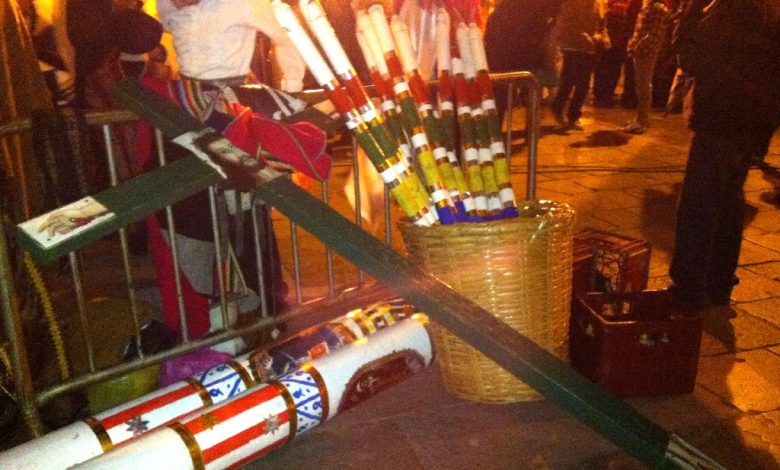
Cuzco’s month of Celebration, June, is filled with events. Last night, Cuzco’s Plaza de Armas embraced a staged performance of one of Cuzco’s emblematic feasts, in all its complexity, the Cruz Velakuy--the Feast of the Cross. Normally held on the night of May 2nd, the Feast was staged for the people and Cuzco and foreigners as Cuzco celebrates itself and its way of life.
During this feast a sponsor, carguyoq, holds a party with food, music, drink, and dance to honor one of the various crosses of Cuzco. They also bring large candles to light and spend the night, the eve of the Feast of the Cross, feasting, dancing, and partying in honor of this important religious and social symbol.
The feast, of course, is a living and changing event. However, the theatrical staging codifies it and attempts to bring back some of the lost traditions, based on much research by the Centro Qosqo de Arte Nativo which organized, developed, and carried out the performance under the direction of Cuzco’s EMUFEC, its Municipal Agency for Festivals in Cuzco.
In what follows you can read some notes, photos, and videos by Walter Coraza Morveli of last night’s event. Walter said that after seeing the performance, he understood this feast more than ever before.


In the beginning the performers entered dancing with all their offerings in hand. These included jurca bread, beer, and chicha. They also carried detentes, small images of the cross, along with miniatures of bread, beers, etc. to place them under the main cross.
Then performers brought in the main cross to music and dance and placed it on the altar raised for the occasion. They dressed the cross in bright colored cloth.
Once the cross was in place, the performers greeted it by bowing before it and praying.
Now they began to dance the various traditional dances to live music supplied by bands and the feast sponsorship. There perhaps three or four bands. The musicians were found in different corners of the scene.
Everyone danced with much happiness and delight. They had some chairs where people sat, conversed, and drank, while the others danced. Some women went around with chicha to serve to each person.
The people became drunk and then food arrived. Ponche, a hot drink of fava beans, also arrived, From one side the ponche was served while from the other plates of food were served to every participant.
This was one dance. They greeted the spectators and then the music changed and a different group of dancers entered. They also greeted the cross. The music began to be played with energy and strength and the dancers began to dance vigorously.
To their side the mactillo and the negrillo (kinds of indigenous, Andean ritual clowns.) They fomented disorder in a humorous form. They tried to break the flow of the dance, and get women to kiss them, and break up the feast in any way they could, with great style and grace. They would flirt, and intimidate, with lots of humor, anything to break the dances’ flow. The public loved them and broke into laughter while the dance continued.
On the other side, the sponsor of the feast, the carguyoc, was drunk. Yet they continued serving spiked tea (te macho). At one point, the carguyoc tried to urinate but the mactillo saw and pulled him back and the mactillo began striking him on his lower legs with a woven sling (warak’a). The carguyoc fell to the ground. He got up, angry, and tried to fight with the mactillo, but people interfered. He put his jacket back on, though now backwards, and had his fly open.
Women passed through the group serving bites of food along with chicha. They would put the food directly into the mouths of the musicians while they were playing so the music could continue and people could dance as the songs and dances changed.
Around the edges performers were beginning to argue and try to fight. While some were dancing, others continued to converse in couples. Some people stumbled with a lot of humor, trying to grab onto others to keep from falling.
It was so real, as if this were the real feast. It contained much of what actually goes on.
Women carrying babies on their back would think the other woman had taken their baby and they would argue.
All of this took place before the cross.
Others would sleep falling off their chairs drunk. Women would help them up.
The music would end and another band would enter with another song with lots of vigor making their presence known. They played the melody for the dance “majenios” which is a representation of drunks drinking.
To the side towers of hand made fireworks went off.
Once again the feast sponsor wanted to urinate without being aware of his surroundings. The mactillo once again struck him with his sling until the sponsor fell to the ground. His clothes were in disarray. Again he tried to urinate on the spectators, but the women would not let him.
Now everyone was drunk. Some would hug each other in groups and the women were laughing happily.
They introduced the sponsors for the next year and they made them drink a lot of beer as they gave they responsibility over to them.
Everyone was dancing a round happily, hand in hand, and the new sponsors were in its center with a flag. shouting out “long live Cuzco” (kausachun Qosqo.)
Though drunk, every one began to gather their things to leave. Children were taking their drunk parents by the hand, making them walk from one side to the other. They left to great applause.
But the sponsors continued there, sitting on their chairs sleeping. Some would almost fall. They would try to stand with a start before sinking back to the chair the best they could. They tried to sleep on the benches, some sitting and some lying down.
The main sponsor was on the ground.
As dawn appeared to break, their helpers who were waiting, woke them up. Then they got ready to leave, combing their hair, and gathering their bundles. With the band playing, the dancers returned and removed the cross, carrying it on their shoulders and all the performers left the scene while the band played a farewell.
With very strong applause from the crowd the theatrical Cruz Velakuy was over.
As people say in Quechua, Cruz Velakuy, trago tomakuy(Sit with the cross, drink lots.)
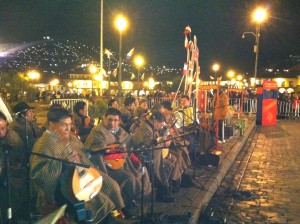
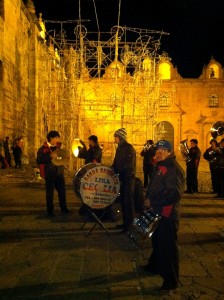
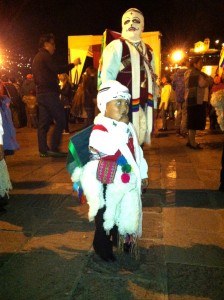

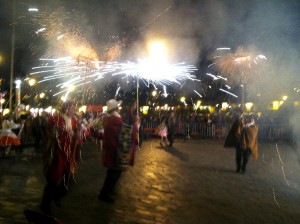
Links for videos to come soon.




